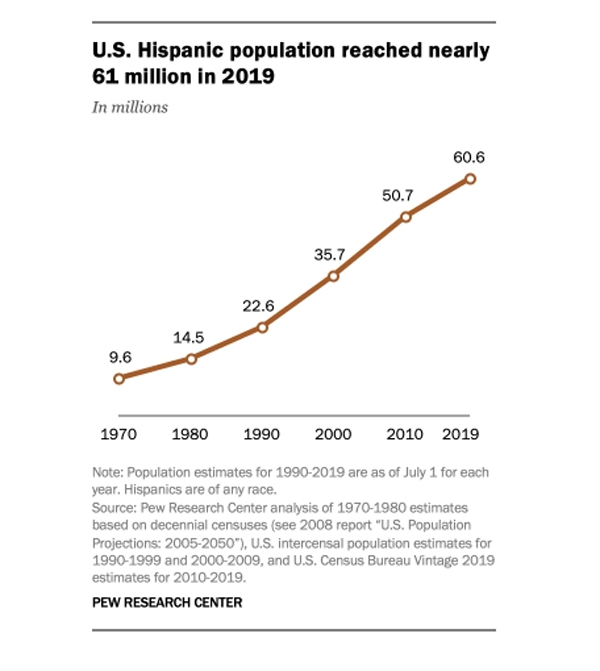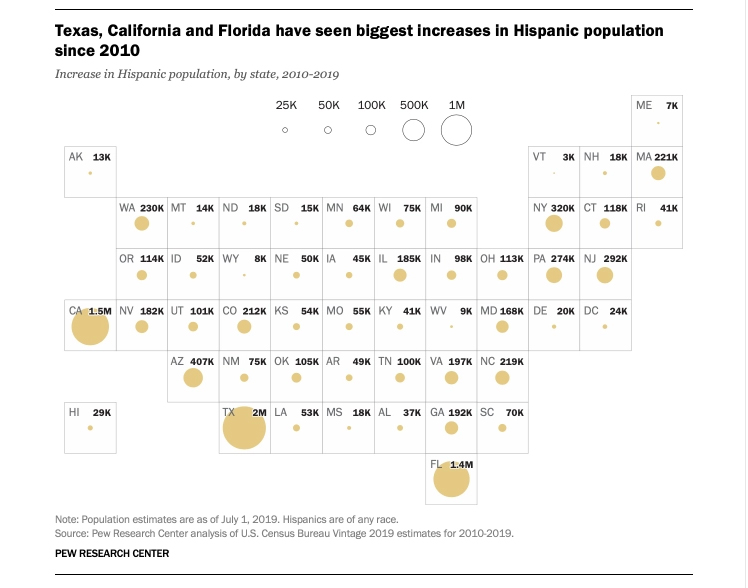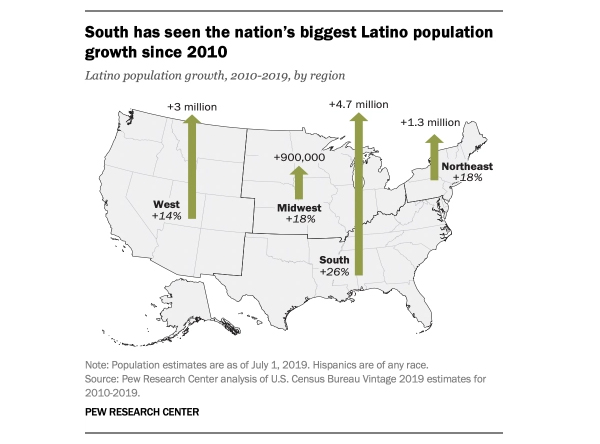
Share On Social!
The U.S. Latino population grew to 60.6 million in 2019, a record 18.5% of the total population, according to new Census Bureau data.
Here are all the details you need to know.
The U.S. Latino Population Continues to Grow
The U.S. population reached 328,239,523 in 2019.
Latinos reached 60,572,237 in 2019.
Now at 18.5% of the U.S. population, Latinos are the second-largest racial/ethnic group, behind non-Latino Whites (60.1%). They have greater numbers than Blacks (13.4), Asians (5.9%), and American Indians or Alaska Natives (1.3%).
 Latinos accounted for 16% of the U.S. population in 2010.
Latinos accounted for 16% of the U.S. population in 2010.
In fact, the U.S. Latino population is up by 10,093,626 from 2010 to 2019, or 20% growth, according to the new Census Bureau data.
Growth of the U.S. Latino Population Is Slowing
Even as the U.S. Latino population continues to rise, growth is slowing down, according to an analysis of the Census Bureau data by Pew Research Center.
The average annual growth rate for U.S. Latinos:
- 4.8%, 1995-2000
- 3.8%, 2000-2005
- 3.4%, 2005-2010
- 2.1%, 2010-2015
- 1.9%, 2015-2019
“Over the past decade … population growth among Hispanics has slowed as the annual number of births to Hispanic women has declined and immigration has decreased, particularly from Mexico,” according to the Pew report.
The U.S. Latino Population Is Young, But Getting Older
In 2019, the median age for U.S. Latinos was 29.8 years.
This is up from 27.3 in 2010.
While U.S. Latinos are getting older, they remain much younger overall than their non-Latino white (44), Black (35), and Asian (38) peers, according to the new Census Bureau and Pew reports.
The U.S. Latino Population Is Growing Rapidly in Certain Counties, Regions
The median size of the Latino population for counties in 2019 was 1,133 people, according to the new Census Bureau data.
 Here are some other key facts:
Here are some other key facts:
- Los Angeles County had the largest Latino population (4.9 million) in 2019.
- “The next largest Hispanic populations were in Harris County, Texas (2.1 million), and Miami-Dade County, Florida (1.9 million). Overall, 11 counties had more than a million Hispanics in 2019. These included Maricopa County, Arizona; Cook County, Illinois; and Riverside County, California. In 104 U.S. counties, Hispanics made up at least 50% of the population in 2019,” according to the Pew Research Center.
- Arizona’s Maricopa County had the largest growth (2.5% or 34,358) among this population between 2018 and 2019.
- Of counties with 20,000 or more people in 2019, the Hispanic population had the fastest growth from 2018 to 2019 in Kaufman County, Texas, increasing by 10.8% (3,093). Since 2010, Luzerne County, Pennsylvania, had the fastest growth, increasing by 103.5% (22,250).
- The Latino population is growing fastest in the U.S. South.
 “[The Latino population in the South] increased by 26% from 2010 to 2019, rising from 18.3 million to 23.1 million,” according to the Pew Research Center. “States in the Northeast (18% increase), Midwest (18%) and West (14%) also experienced growth in the number of Latinos from 2010 to 2019.”
“[The Latino population in the South] increased by 26% from 2010 to 2019, rising from 18.3 million to 23.1 million,” according to the Pew Research Center. “States in the Northeast (18% increase), Midwest (18%) and West (14%) also experienced growth in the number of Latinos from 2010 to 2019.”
Why Is the Health of U.S. Latinos Important?
The rise of the Latino population across the United States makes it imperative to address health gaps in this population. Otherwise, the future health of the nation would be compromised.
And the health gaps are quite large.
Latinos struggle with:
- healthy food access
- safe places for physical activity
- housing and transit
- social support
- mental health issues and childhood trauma
- healthy school environments
- toxin and pollution exposure
And, most recently, the novel coronavirus COVID-19 is worsening these very health inequities. This includes higher case and death rates for Latinos.
“Latino and African-American residents of the United States have been three times as likely to become infected as their white neighbors, according to the new data, which provides detailed characteristics of 640,000 infections detected in nearly 1,000 U.S. counties,” The New York Times reported in July 2020. “And Black and Latino people have been nearly twice as likely to die from the virus as white people, the data shows.”
What Can We Do to Improve U.S. Latinos’ Health?
We can all do our part to promote community health equity.
Start with a customized Salud America! Health Equity Report Card to see how your area stacks up in housing, transit, poverty, health care, and other health equity issues compared to the rest of your state and nation.
You can then email your Health Equity Report Card to decision-makers, share it on social media, and use it to make a case for community change to boost health equity for the long-term.
Then you can take some targeted actions:
- Download the Salud America! “Handle With Care Action Pack” to start a Handle With Care program. In the program, police notify schools when they encounter children at a traumatic scene, so schools can provide support.
- Download the free Salud America! “Get Your City to Declare Racism a Public Health Crisis Action Pack“! The Action Pack will help you gain feedback from local social justice groups and advocates of color. It will also help you start a conversation with city leaders for a resolution to declare racism a public health issue along with a commitment to take action to change policies and practices. It will also help build local support.
By The Numbers
44
million
immigrants live in the United States



